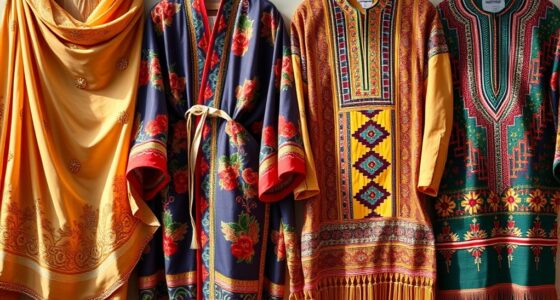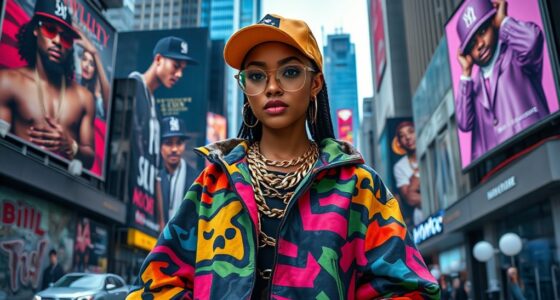Fashion weeks worldwide are vibrant celebrations of culture, showcasing traditional attire, craftsmanship, and regional art. They serve as platforms to preserve and promote local identities, blending heritage with modern trends. These events capture history, social shifts, and cultural stories through innovative designs and storytelling. By highlighting indigenous symbols and craftsmanship, fashion weeks foster cultural pride and sustainability. Stay with us, and you’ll discover how these events shape and reflect evolving cultural identities across the globe.
Key Takeaways
- Fashion Weeks showcase regional heritage by integrating traditional motifs, textiles, and craftsmanship into modern runway collections.
- They serve as platforms for cultural storytelling, reflecting societal history, movements, and evolving identity through design.
- Designers collaborate with local artisans, preserving indigenous techniques and promoting community engagement and cultural sustainability.
- Events highlight regional influences, native fabrics, and handcrafted textiles, emphasizing cultural pride and traditional craftsmanship.
- Future trends include digital integration, augmented reality, and inclusive narratives that blend cultural preservation with technological innovation.
The Cultural Significance of Fashion Weeks
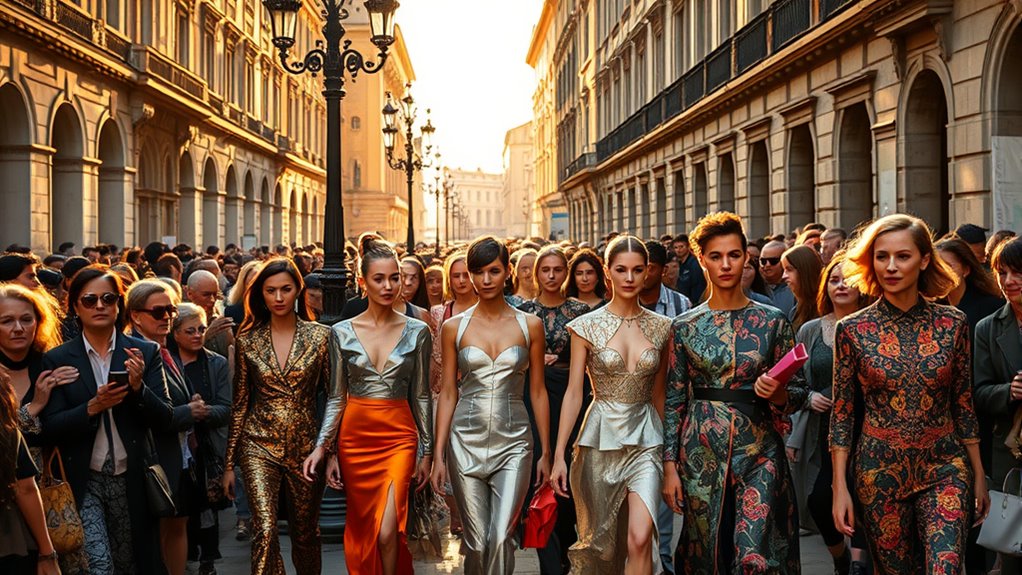
Fashion weeks are more than just runway events; they are powerful expressions of culture and identity. When you attend or watch these shows, you’re witnessing stories that reflect a society’s history, values, and traditions. Designers often incorporate local motifs, textiles, and craftsmanship, showcasing their cultural heritage to the world. These events help preserve and celebrate unique customs, giving communities pride and visibility. Additionally, fashion weeks can challenge stereotypes by blending traditional and modern elements, fostering dialogue about cultural evolution. For you, participating in or observing these moments means engaging with a deeper narrative about identity, belonging, and the ongoing dialogue between past and present. They serve as platforms to honor cultural roots while inspiring future generations. The use of traditional textiles and motifs in runway collections highlights the importance of cultural preservation in contemporary fashion. Incorporating psychological research-backed design elements can also enhance the cultural storytelling and emotional impact of these collections. Moreover, the presence of authentic craftsmanship emphasizes the value of preserving artisanal skills in the global fashion landscape. Furthermore, these events often promote sustainable practices by highlighting local artisans and eco-friendly materials, contributing to a more conscious fashion industry.
Traditional Attire and Contemporary Trends
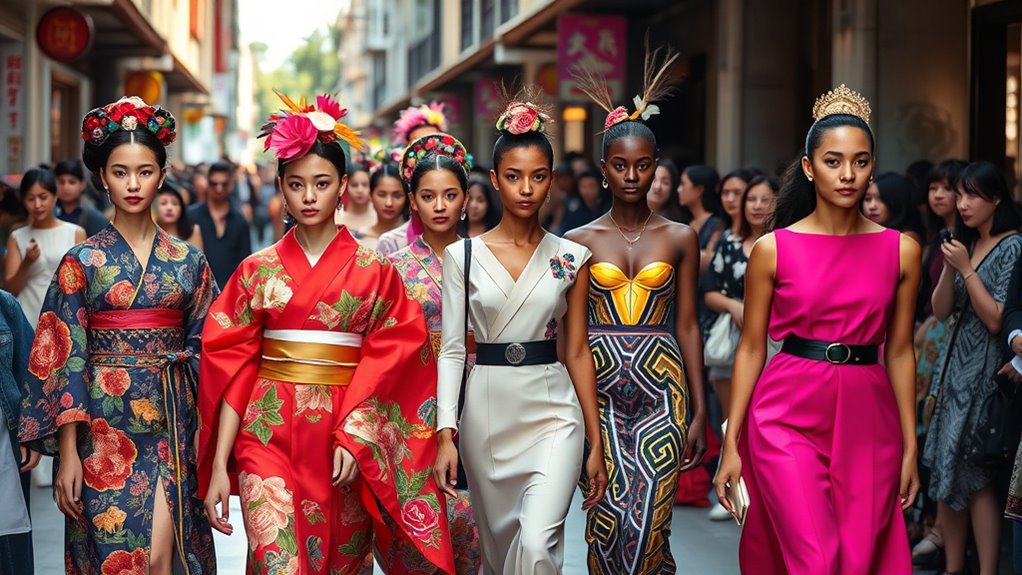
Traditional attire often serves as a powerful symbol of cultural identity, but contemporary trends are reshaping how these garments are worn and appreciated. You see designers blending traditional elements with modern styles, creating innovative looks that honor heritage while appealing to current fashion tastes. For example, vibrant embroidery or distinctive fabrics are incorporated into everyday wear, making cultural symbols more accessible. Fashion weeks showcase these fusion styles, allowing you to experience how tradition evolves in real time. Many young designers reinterpret traditional attire, emphasizing sustainability practices and cultural pride. Additionally, contemporary fashion trends are increasingly influenced by global collaborations, further blending cultural expressions. As a result, you might notice traditional patterns, silhouettes, or textiles featured prominently on runways, but with a modern twist. This blending of old and new helps keep cultural attire relevant and vibrant in today’s global fashion scene, fostering a deeper appreciation for diverse heritages worldwide. Moreover, innovative production techniques have made traditional textiles more environmentally friendly, aligning cultural fashion with sustainable development goals.
Fashion as a Reflection of Historical Narratives

Clothing often tells stories beyond mere aesthetics, serving as a visual record of historical events, social movements, and cultural shifts. Fashion captures moments of change, rebellion, or progress, allowing you to see history through fabric and design. For instance, wartime austerity influenced minimalist styles, while the 1960s’ vibrant colors reflected social revolutions. Fashion can symbolize political statements or societal values at specific times. Here’s a visual overview:
| Era | Fashion Reflection |
|---|---|
| Post-War 1940s | Revival of traditional elegance |
| 1960s Civil Rights | Bright, bold expressions of social change |
| 1980s | Power dressing as empowerment |
| 2000s | Tech-inspired, globalization influences |
This table illustrates how fashion echoes the narratives of each period, allowing you to interpret history through clothing choices.
Regional Influences and Local Artistry
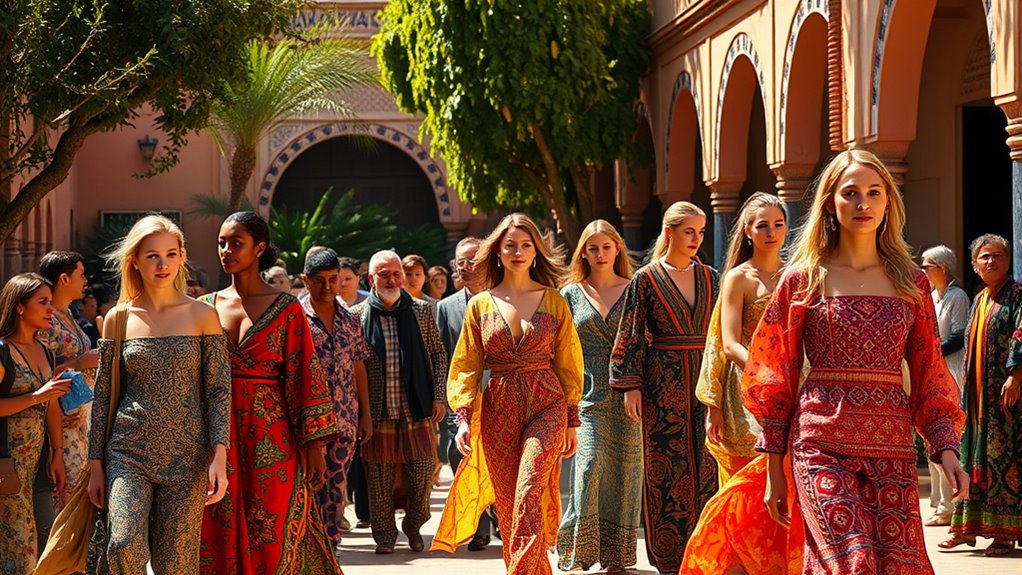
You’ll notice how designers incorporate traditional crafts and local techniques into their collections, creating a unique sense of place. Indigenous motifs often serve as bold statements that honor cultural heritage and tell stories through fabric and pattern. By embracing these elements, fashion weeks become platforms for celebrating regional artistry and craftsmanship. Incorporating regional influences into designs not only enriches collections but also supports local artisans and preserves cultural traditions. Additionally, highlighting authentic craftsmanship helps to maintain the integrity of traditional methods amidst modern fashion trends. Recognizing the importance of cultural preservation, many designers actively collaborate with indigenous communities to ensure respectful and accurate representation. This focus on local artistry underscores the significance of community engagement in sustaining traditional techniques. Promoting cultural sustainability is essential for maintaining the diversity and richness of world fashion heritage.
Traditional Craft Integration
As designers seek to honor cultural heritage, they often incorporate regional crafts and local artistry into their collections, creating a vibrant dialogue between modern fashion and traditional techniques. By doing so, they preserve unique craftsmanship methods like hand weaving, embroidery, and beadwork that have been passed down through generations. These elements add authenticity and depth to runway presentations, highlighting the skill and stories behind each piece. You’ll notice how designers collaborate with local artisans, blending contemporary silhouettes with age-old practices. This integration not only elevates cultural appreciation but also supports local economies and keeps traditional crafts alive. Additionally, showcasing authentic regional details can influence global fashion trends, inspiring broader appreciation for traditional craftsmanship. When you see these collections, you’re witnessing a celebration of heritage that respects both innovation and history, fostering a deeper connection to the origins of each region’s artistry.
Indigenous Motifs Emphasis
Indigenous motifs have become a powerful way for designers to infuse their collections with regional identity and cultural significance. By incorporating traditional patterns, symbols, and textiles, you connect fashion to local stories and histories. Here are three ways this influence shows up:
- Authentic Patterns: Designers often feature indigenous prints that carry deep cultural meanings, transforming them into contemporary statements.
- Symbolic Embellishments: You’ll see motifs like tribal symbols or sacred designs embroidered or printed onto garments, honoring their origins.
- Local Materials: Many designers use native fabrics or handcrafted textiles, emphasizing craftsmanship and regional artistry.
- The incorporation of heritage elements in fashion also fosters greater appreciation and awareness of indigenous communities and their traditions.
This focus elevates indigenous cultures, making their motifs central to modern fashion while respecting their heritage.
Globalization and Its Impact on Cultural Identity
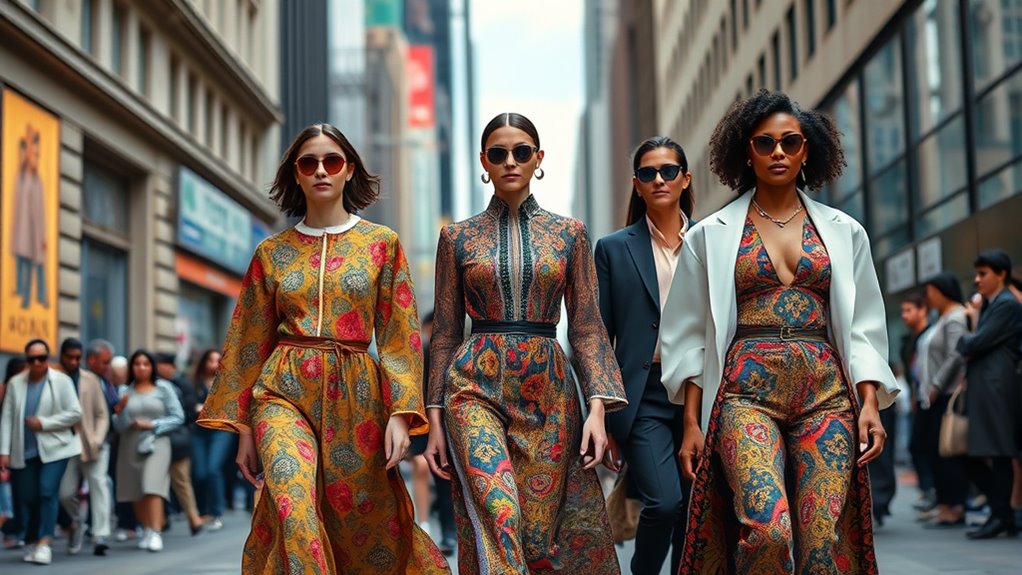
Globalization has profoundly transformed the fashion industry, influencing how cultural identities are expressed and perceived. You now see a blend of styles, fabrics, and symbols from different parts of the world, creating a global fashion language. This interconnectedness allows designers to showcase diverse cultural elements on major runways, but it also risks diluting authentic traditions. You might notice cultural motifs adapted for mass appeal, sometimes losing their original meaning. While globalization broadens access and fosters cultural exchange, it can also lead to cultural homogenization, where unique identities become less distinct. The rise of cultural appropriation in fashion highlights both the opportunities and challenges of this interconnectedness. As you follow fashion weeks worldwide, you observe how local cultures are both celebrated and commodified, shaping perceptions of identity in a rapidly interconnected world. Additionally, the influence of globalization can sometimes overshadow local fashion narratives, making it essential to recognize and respect the origins of cultural symbols. Recognizing the importance of cultural preservation ensures that authentic traditions are maintained amid these global influences. Cultivating creative practice within local communities can help preserve these unique identities and promote authentic cultural expressions. Emphasizing cultural authenticity can serve as a counterbalance to commercial influences, safeguarding the integrity of traditional designs.
Sustainable Fashion and Cultural Preservation
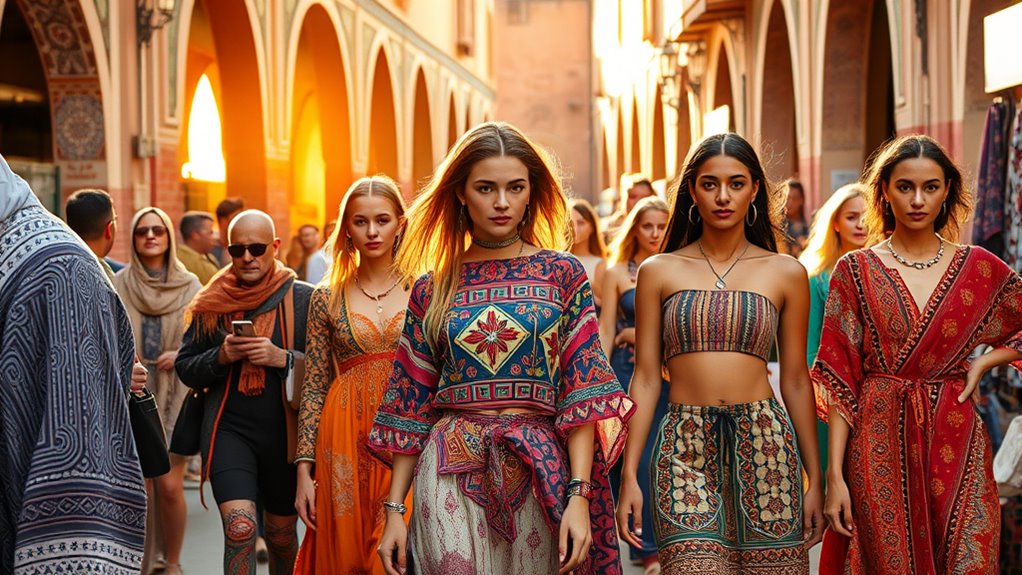
You can see designers embracing traditional techniques and eco-friendly materials to create stunning, sustainable fashion. These efforts help preserve cultural identities while reducing environmental impact. By supporting such initiatives, you contribute to a more responsible and culturally rich fashion industry. Additionally, integrating eco-conscious materials aligns with the growing trend of sustainable fashion and the importance of transparency in supply chains. Ensuring durability and quality of eco-materials is essential for their longevity and effectiveness in fashion production.
Traditional Techniques Revival
As designers and fashion houses seek more sustainable practices, there’s a growing movement to revive traditional techniques that honor cultural heritage. You can see this in various ways:
- They incorporate age-old methods like hand weaving and embroidery, keeping craftsmanship alive. For example, many brands now emphasize traditional craftsmanship as a way to preserve artisanal skills and promote sustainable production methods.
- They adapt traditional patterns and motifs into modern designs, blending history with contemporary fashion.
- They work directly with local artisans, supporting communities and preserving indigenous skills.
- This movement also parallels trends in the entertainment industry, such as the rise of cultural preservation efforts in global pop culture, emphasizing the importance of maintaining traditional knowledge. Additionally, some designers are experimenting with wicks and natural waxes to create eco-friendly candles that incorporate cultural symbolism into their collections.
This revival isn’t just about aesthetics; it’s a conscious effort to reduce environmental impact and maintain cultural identity. By embracing these techniques, you help sustain ancestral knowledge and create unique, meaningful pieces. It’s a powerful way to connect fashion with history and promote responsible consumption.
Eco-Friendly Material Use
In the pursuit of sustainable fashion, designers are increasingly turning to eco-friendly materials that respect both the environment and cultural heritage. You can see this shift in the use of organic cotton, hemp, and bamboo, which lower environmental impact and honor traditional cultivation methods. Natural dyes derived from plants and minerals replace synthetic colors, reducing chemical waste. Some designers incorporate locally sourced, traditional textiles like handwoven fabrics or recycled materials, emphasizing cultural significance while minimizing waste. By choosing these materials, you not only support eco-conscious practices but also help preserve artisanal techniques and cultural identities. This approach fosters a deeper connection between fashion, sustainability, and cultural respect, making your choices at fashion weeks meaningful and impactful beyond mere aesthetics.
Cultural Identity Preservation
Sustainable fashion isn’t just about eco-friendly materials; it also plays an essential role in preserving cultural identities rooted in traditional craftsmanship. When you support local artisans and indigenous designers, you help uphold unique techniques and designs passed down through generations. Here are three ways it makes a difference:
- Reviving Traditional Skills: Promoting handcrafted techniques keeps ancient methods alive, preventing their extinction.
- Celebrating Cultural Heritage: Showcasing authentic designs on global platforms elevates cultural stories and meanings.
- Empowering Communities: Investing in local craftsmanship provides economic opportunities and ensures cultural continuity.
Future Perspectives: Evolving Identities and Creative Expressions
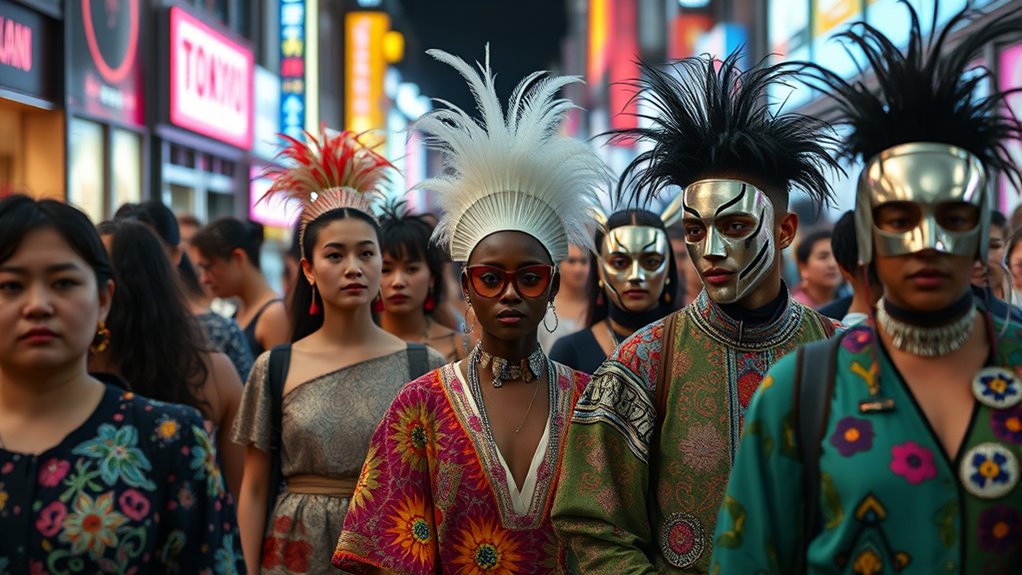
The future of fashion weeks will be shaped by rapidly evolving identities and bold creative expressions that push boundaries and challenge conventions. You’ll see designers blending cultural influences, technology, and sustainability to craft innovative shows. Expect more inclusivity, with diverse models and narratives reflecting global voices. Creative expressions will become more experimental, merging virtual and physical experiences, making fashion accessible worldwide. Visuals will become more dynamic, emphasizing personalization and storytelling. To illustrate, consider this picture:
| Evolving Identities | Creative Expressions |
|---|---|
| Cultural hybridity | Digital fashion shows |
| Inclusive narratives | Augmented reality integrations |
| Sustainability focus | Wearable tech innovations |
| Youth-driven trends | Interactive audience participation |
| Globalization | Customizable, personalized pieces |
Frequently Asked Questions
How Do Fashion Weeks Influence Local Economies and Tourism?
Fashion weeks boost local economies and tourism by attracting visitors, designers, and media from around the world. You’ll find increased spending on hotels, restaurants, and transportation, providing a financial boost to the area. These events also promote the city’s culture and style, drawing more tourists year-round. As a result, fashion weeks create a buzz that benefits local businesses and elevates the city’s global reputation, making it a vibrant hub for fashion and culture.
What Role Do Social Media Platforms Play in Global Fashion Dissemination?
Oh, social media’s just there to make you think you’re a fashion expert overnight, right? In reality, it’s your biggest tool for global fashion dissemination. You get instant access to runway shows, trends, and designer insights, all at your fingertips. Platforms like Instagram and TikTok break down barriers, turning local styles into worldwide phenomena. You become part of the fashion conversation, influencing and being influenced in real time—no passport required.
How Do Fashion Weeks Support Emerging Designers From Underrepresented Regions?
Fashion weeks directly support emerging designers from underrepresented regions by giving them a platform to showcase their work. You can attend runway shows, participate in designer showcases, and gain exposure to industry professionals and media. These events help you build networks, attract buyers, and gain recognition. By spotlighting diverse talents, fashion weeks foster inclusivity and cultural exchange, empowering you to break into the global fashion scene and share your unique perspective.
In What Ways Do Fashion Weeks Challenge Traditional Gender Norms?
You see, fashion weeks challenge traditional gender norms by showcasing gender-fluid designs and featuring models who defy stereotypes. They push boundaries through bold runway presentations, blending masculine and feminine styles, encouraging acceptance and diversity. When you attend or watch these events, you witness a shift towards inclusivity, empowering individuals to express themselves freely beyond conventional gender expectations. This evolution helps foster a more open and accepting fashion industry and society at large.
How Are Digital Innovations Transforming Fashion Presentations Worldwide?
Imagine a world where your runway shows are just a click away. Digital innovations revolutionize fashion presentations by making them more accessible and immersive. You can attend virtual shows, explore 3D designs, and share experiences instantly across social media. These advances break down geographical barriers, giving you a front-row seat from anywhere. As technology evolves, your fashion experience becomes more interactive, personalized, and inclusive—changing the way you see and engage with style.
Conclusion
As you explore fashion weeks worldwide, remember they’re more than runway shows—they’re living tapestries of culture and history. Each collection echoes centuries of tradition, modern innovation, and global influences, much like an ancient Greek scroll brought to life on a digital tablet. Embrace these events as a testament to evolving identities and creative expressions, where sustainability and cultural preservation hold the key. In this grand fashion odyssey, your appreciation shapes a future that respects the past while boldly stepping into tomorrow.


